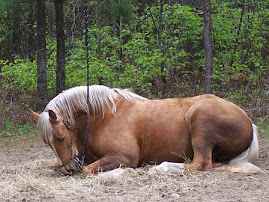
Anyone who has been stepped on, bitten, otherwise mugged, shoved, slammed against a wall, dragged across the yard,
much less thrown, carted, tree-slammed, bushwhacked, dumped unceremoniously in the shrubbery, or just plain bucked off by a horse, has had occasion to wonder:
Is it just me, or is my horse being a Butt-head?"It's such a serious question. If it's just me,over-reacting to pain and humiliation, pain and shame are part of normal horse life and real cowgirls would barely take notice. Ho-hum, another dirt-dive.
If my horse is being a Butt-head, well hey-ho for the trailer-oh because Dobbin, your hiney is for sale!!!
But wait: the true horseperson is capable not only of bruising and breaking (including the bank), but also of internalizing all the moral weight that goes with this thought:
"Perhaps this is all my fault!"And indeed, all the wise horse people down through the ages from Xenophon on have shouted out this truth: You are getting from your horse exactly what you put in.
So when it is time for a bit of behavior modification, 'gentle leadership', or equine Butt-Head remodeling, we must all share strategies and here are some my friend Kathy shared with me yesterday.
1. The Horse stands still when tied and for grooming.

a. This is the start of the more formal part of your interaction and he is already at work, therefore under the rules you enforce.
b. If he moves, you immediately move him back to where he was. As many times as it takes. If he swings his haunches and steps over, back he must step.
c. When he stands appropriately you stop staring at him and that's his release. Give him a moment of quiet. Be prepared for this to take a lot of time and to reappear daily or hourly until you have settled this rule into a stone tablet that reads "Thy Horsey Commandments".
2. The Horse lowers his head upon request.

a. This is achieved by gently pulling at the lead rope under his chin. Immediately release a bit when you get a downward try. Release = reward.
b. You may suspect that your horse is actually scouting the ground for molecules of food, as John appeared to be doing; reward nevertheless.
c. He should eventually give this response in one smooth slow motion; "head down", down it goes, food-radar engage!
3. The Horse moves away from pressure.

He does this standing, walking, etc. and you are moving him rather than him deciding to mosey about.
a. It's particularly great when he moves his hindquarters and steps under himself: great exercise, work, and submission all rolled into one.

b. You achieve this by using the tail end of the lead rope as a little spinner, or waver, or Morse-code sender; whatever you and your horse like and find comfortable.
c. He may move away too fast deciding "Time to Book Out of Here!"

If so, you stop him, perhaps back him up a few steps by standing in front of him and making semaphore signals with your hands while producing sound effects of an appropriate nature. Whatever is your backing routine. If you don't have one, this is worth developing in itself.
4. The Horse is not the Decider; you are the Decider. It can be about something as trivial as what to stare out during ground work. "You must have his mind", Kathy said many times yesterday.

If you find him wandering off into mental La-La Land, just ask him to do something; it doesn't matter what.
I know people who work on this every day. Kathy does it with her horse once a week. I plan to do it before every ride and make it part of our routine; at first more, then less perhaps as John becomes the polite and sweet horse he was born to be and loses his chew-your-pocket ways. I hope.
And I do believe that ground work translates into under-saddle work because it is all work, all part of the rule-structure we build for a relationship with an animal who weighs upwards of 1,000 pounds.
Yeeps!

















+of+Copy+of+sat+020.jpg)
+of+Copy+of+sat+086.jpg)
+of+sat+024.jpg)
+of+sat+042.jpg)

































